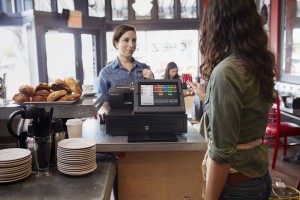Each new year brings changes, reaffirmation of trends and patterns, and new developments. In the retail and hospitality space, expect to see in 2017 a continuation of the trend toward mobility, cloud-based solutions and the emergence of Unified Commerce strategies. Some belt-tightening is also likely as these industries wade through economic and political uncertainties, particularly in Europe.
Here’s a forward look at the coming year:
We are seeing more and more customers, in the U.S. and globally requesting product designed for tablets and mobile POS. There is a difference: Although both solutions are typically cloud-based and thin client-based, one is stationary and the other is well, mobile. This aligns with a trend in hospitality, convenience, retail and service stations to use tablets for checkout and data access. With mPOS gaining traction, especially in the SMB space, heavy-duty peripherals are giving way to more cost-effective hardware. Rather than spending thousands of dollars on POS components, companies now are spending hundreds.
- EMV and Brexit/Political/Economic Uncertainty
In the European Community, for instance, the Brexit vote and a recent referendum in Italy have created some economic uncertainty. For U.S. automated fuel merchants, the EMV liability shift has been pushed out from 2017 to 2020. Key decision makers within the retail petroleum industry may hold off on POS upgrades as the new EMV deadline approaches. These political, economic issues and compliance uncertainty have retailers holding onto their hardware for extended periods of time.
- Bricks and Mortar vs. Online
Brick-and-mortar retail is alive and well, despite online competition. Online retailers such as Amazon are crossing into the physical domain while physical stores strive to offer a more online-like experience by, for instance, making tablets available for transactions and information lookup. Shoppers can place orders from home for store pickup and vice versa. The future of retail will combine elements in an emerging Unified Commerce. In many cases the retail store is becoming a local warehouse.
- Mobile Wallets Buzz
Despite all the buzz around mobile wallets such as Apple Pay and Google Wallet, they haven’t displaced cash – nor are they likely to. Some mobile wallet users are going back to cash. As consumers become more budget-conscious, many would rather budget with cash and spend accordingly, and avoid the blind spending that comes with mobile wallets – or credit cards, for that matter. While some users will prefer the convenience of electronic payments, ultimately what we’ll see is a healthy mix of plastic, electronic and cash payments.
- Industry Consolidation
Mergers and acquisitions are always a feature of a mature market, so activity in the POS space is bound to continue. Consolidation likely will continue as payment processors step into the POS hardware space and ISVs merge. The large players will continue to acquire portfolio accounts to expand or complete their solutions offering.
The trend to deploy POS systems and peripherals in the cloud will continue to gain traction in a pay-as-you-go model that makes it easier for customers to access the latest technology and keep their systems updated. For resellers, this approach creates opportunities to build value-based services around your offerings and increase profit margins. POS systems are being integrated through the cloud not only with peripherals but also payment card services and backend solutions. This disruptive philosophy is reshaping the POS technology space.
- Unified Commerce
Largely driven by millennial shoppers, who expect an in-store experience similar to online shopping, retailers are developing Unified Commerce strategies to serve consumers when, where and how they prefer to complete transactions. Rather than having multiple channels, Unified Commerce streamlines communication to one single software platform, linking existing legacy applications and providing a holistic shopping experience. A step beyond Omnichannel, Unified Commerce connects physical stores, online and mobile app stores, telephone sales and any other transaction methods all in real time. Retailers also are starting to personalize service with promotions tailored to groups and even targeted at individual shoppers. These trends will drive much of the retail industry’s IT investments in the coming year.
- Reduced Labor Pool, Rising Minimum Wage and New Overtime Rules
Labor and compensation will continue to be an issue in the coming years. Retailers are challenged to find enough qualified help regardless of the position. The rising minimum wage and the new overtime rules only exasperate the problems. Retailers will be looking for solutions that can help control store-level labor or help reallocate the labor back into customer service activities.
We would love the opportunity to meet with you at NRF 2017. Schedule a meeting today to learn more about the cash management solutions that can increase your operational efficiency, reduce cash loss and reallocate labor to provide a better customer experience overall.








